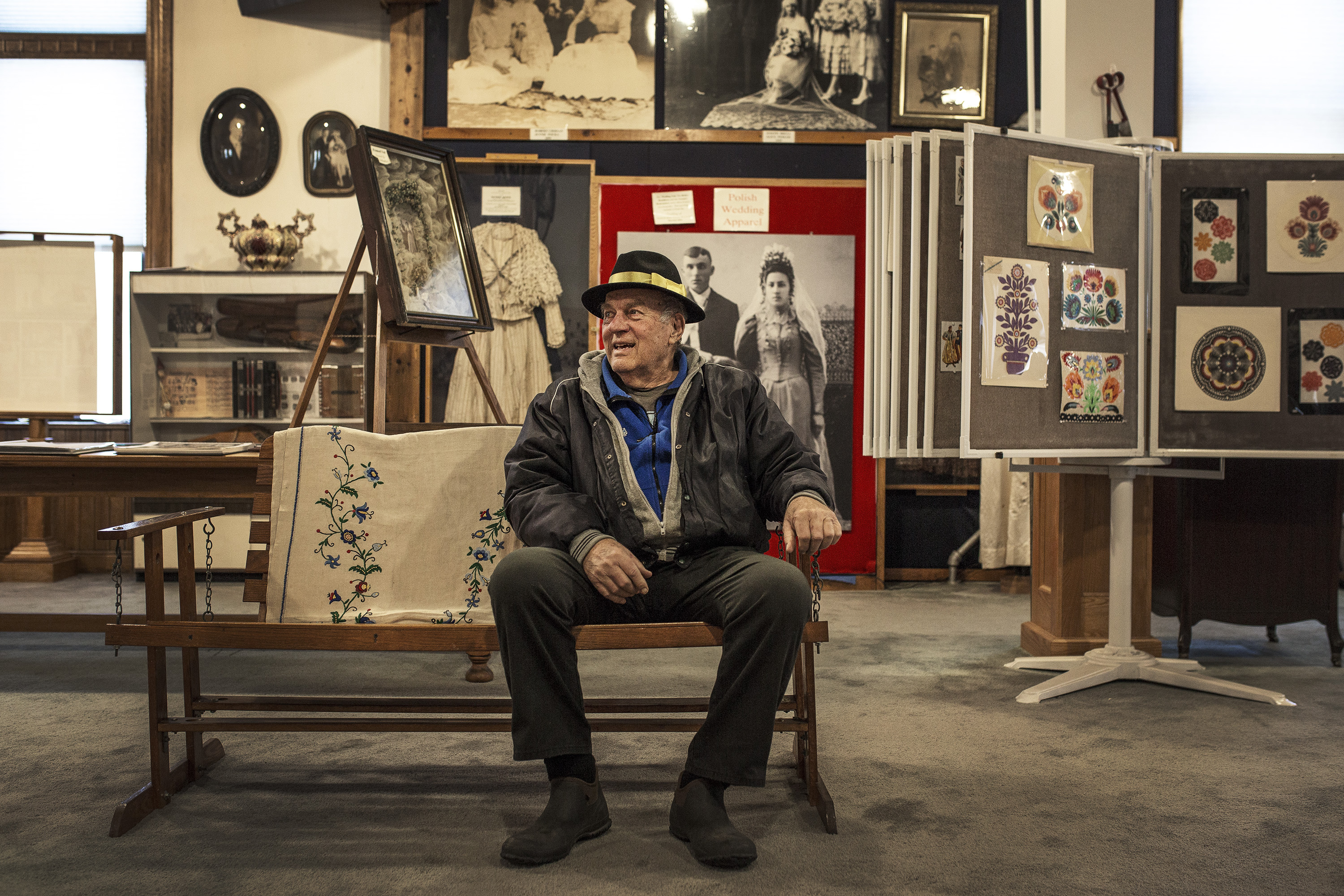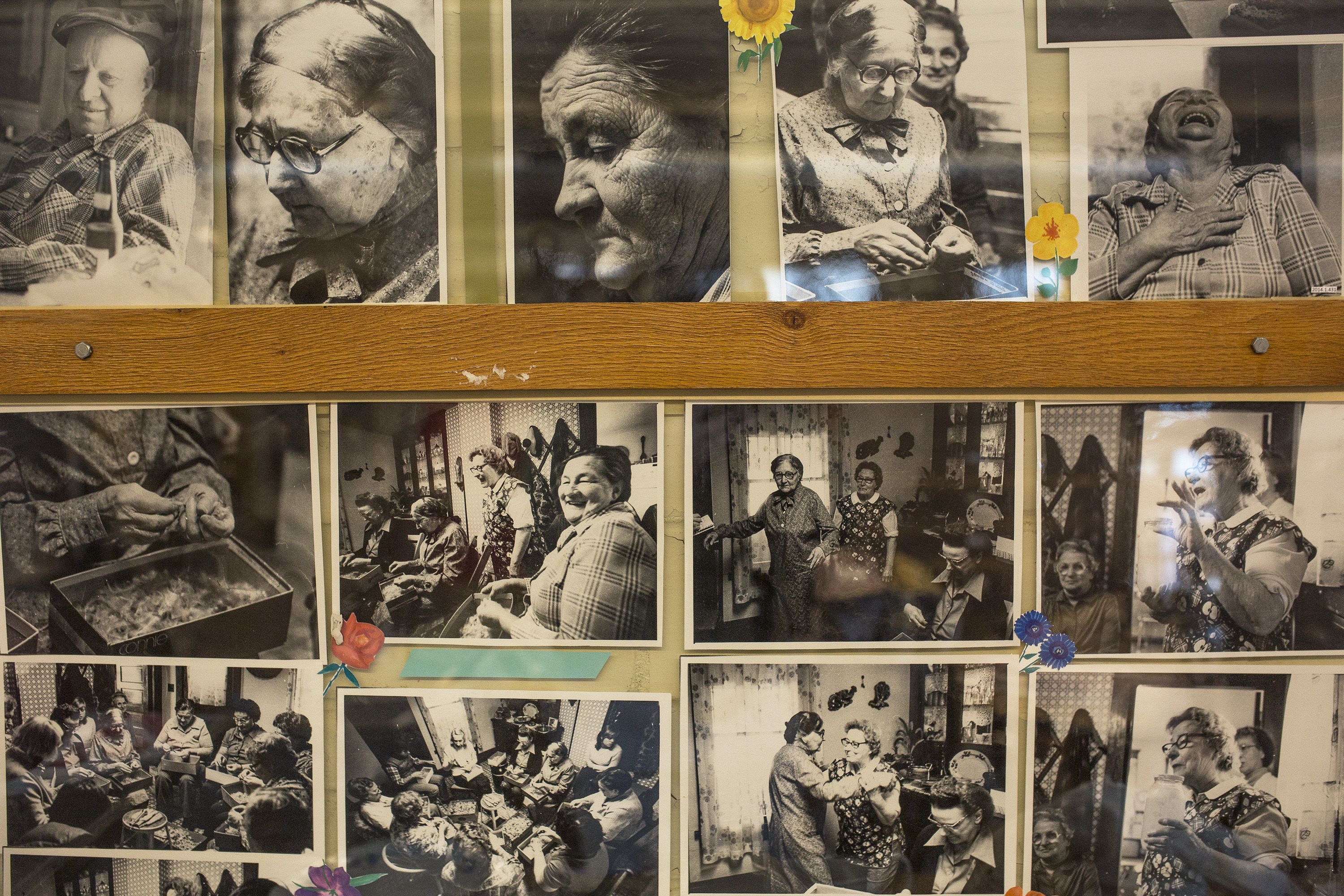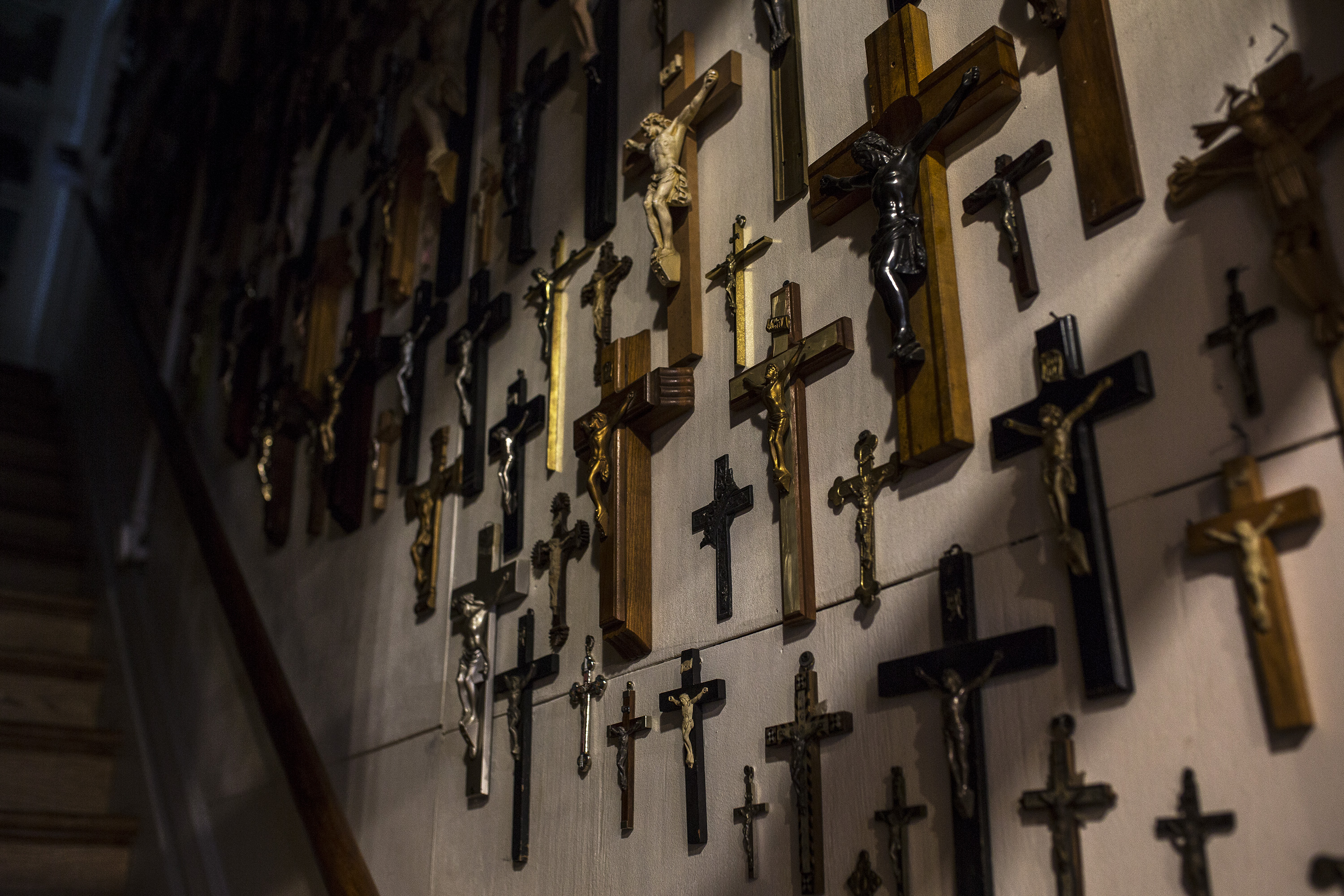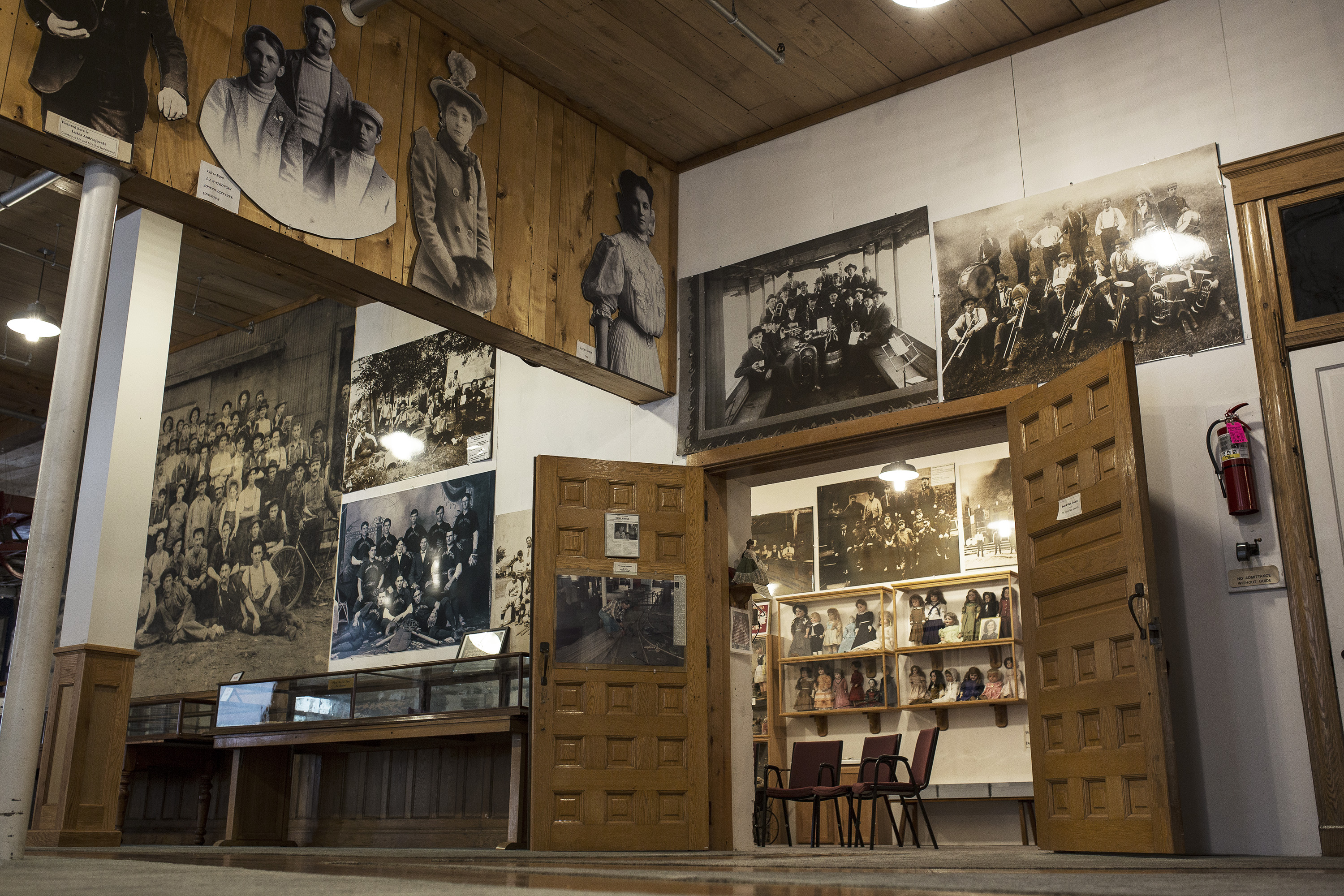Father Paul Breza: 84 years on the East End and counting … in Polish.

As told to Jerome Christenson, with photographs by Chuck Miller. This piece was originally published in 2022.
One day my sister called me to her house, we were sitting in the basement and she said, “I want you to change the Polish people’s attitude toward themselves. They believe that we’re dumb Polacks. They believe all the stuff that people say about them, that you can’t do this, you can’t do that. It’s the wrong side of town, you don’t want to visit there. All this…you’ve got to change that attitude.”
“You’re talking about a lifetime occupation,” I said. “That’s not one weekend.”
“I know, I’ll help you with it. Just do it. I want you to do something to involve the city of Winona so you can change their attitude. I want them to know they’re good for something, that they’re great people, they’ve got good ability.”
I said, “Well, we’ll start.”
So that’s when we first put together the Polish Heritage Dinner—for Polish Constitution Day in 1976.
I talked St. Mary’s College into doing the dinner because all the people on the maintenance staff out there were Polish—all the cleaning ladies, all the men who work in the boiler room, they’re all Polish people. I said, “You do stuff for rich people, for your donors, why don’t you do something for the donors who don’t give you money, but give you their time?”
When he heard what we were going to do, Roy Literski said, “You won’t sell 50 tickets, or something like that. Who’s going to go to that?”
Well, we wound up selling over 300 tickets the first day they were on the market, then we had to call the sale off or we wouldn’t have room for the guest speaker and the choir. That’s what started it. The next year we sold almost 400 tickets in 15 minutes, and we were on our way.
***
We started having meetings and kept going. After the second year we had all this stuff and, people said we don’t want it back because we’re getting old and old dresses, kid’s clothes, Polish prayer books…who’s going to use that stuff? Why don’t you keep it?
So I kept it in storage, but then it got bigger and they said you’ve gotta go look for a place, and that’s when I picked this up. It was called the Polish Cultural Institute.
I had a guy come in today, he said this is one of the highlights, one of the hidden gems of Winona. It draws people to Winona. You wouldn’t believe how many people…people from out of town think it’s fantastic.
When people come in the summertime, if they’re from Poland they’ll remark about the saints’ books that are written in Polish, the books the grandmas used to read to the kids on Sundays. You weren’t allowed to work on Sunday so they would sit in the living room and grandma would read stories about Adam and Eve, Cain and Abel, Noah and the ark and the big flood, and all the great things that were written about—they’re all in these big saints’ books. A pilot from Poland said, “You don’t realize how valuable these would be back home. These are worth hundreds of dollars.”
Well, I’ve got them here because they were going to the dump. Nobody here spoke Polish.
That caused a little difficulty with the museum. We are from the northern part of Poland, that’s Kashubian Poland and Kashubian isn’t spoken in the rest of Poland. We fight with other Polish people about whether we’re using the right words. When people come down here from the Twin Cities they tell us, you guys don’t speak Polish. That sign on your door is a mistake. I say, no it’s bad Polish, but very good Kashubian.

***
Back there we have a letter found in a silverware drawer. It said, all in Polish, “We have sold our farm. We are coming to live in Winona. We don’t know what to do with the three orphans of your family that we were raising. We can’t afford to bring them—they cost 50 thalers apiece.” I don’t know what a thaler is, but it might be a dollar. Any way, they were writing to see if they could find somebody already here—making the big money over here, to send back to have the kids sent over.
I never found the answer to it, but at the very bottom it said, “Please say hello to Anton Pehler,” and that happens to be my great grandfather.
***
I had two sets of grandparents on Second Street, one just four blocks from here, the other lived next to the knitting mills. One, Anton, my great grandfather, was in the Civil War.
Now he never worked for the sawmill, but he could play the sweet potato—you know what that was? Ocarina. Three of his girls were in vaudeville, one of the girls was first secretary to the man who engineered the Panama Canal. But, who knows this stuff? We were obviously important, but who knows anything about it? It’s because they couldn’t communicate.
They had clubs and they had organizations that nobody knows about. My mom talked about a club where the women would meet—I have pictures of them—all with the same hairdo, big bouffant hair. We had bands, Polish bands… but where are they? All those pictures I have on the wall is all that’s left.
The guy who wrote Winona history out at St. Mary’s College would say, “Nah, they were all workers, laborers, there wasn’t any talent among ‘em…”
I said no, they just couldn’t practice their talents. You couldn’t be a herbologist, which we had living next door. You couldn’t be a druggist, couldn’t be a school teacher, because they didn’t speak English. So you had to survive, you had to do something to live, and so you would cut wood. There were three sawmills in Winona, they hire 2,000 guys to work there. By 1910 we were out of trees and 2,000 men were out of work. Man that was a tremendous loss, 2,000 jobs gone?

***
I was born in 1937. Went to school at St. Stan’s. Went to Cotter High School, went to St. Mary’s College, everything local. Because I was also supposed to be a down-trodden Polack, y’know—and technically, I still am.
When I was a kid, the playground was just dirt, the rec center was mostly closed, but it was a place to meet. The kids from grade school would get picked up by Mr. Langowski, who would take them out to pick strawberries at his farm—5 cents or 10 cents a quart. The newspaper boys were all Polish, and they’d go right from St. Stan’s School to the back of the rec to pick up their papers that were dropped off in bundles, and they’d deliver them to the whole East End. We had ice skating in the winter time, Palbicki could show off on skates, the Bambeneks would be down there skating. We had Winter Carnivals that were just fantastic.
Still, you grow up with this idea of a backward East End. You can’t go to the East End, they’re all ruffians, y’know…garbage piled all over, the hog line… all these things that are contrary to what we’re trying to say now.
We’d like to change that attitude, and it’s already happening.
***
There were little things we were trying to work at, and they’re starting to come to life. People got together and they came up with the Sobieski Park Lodge. We started giving out our door knockers as an award for home beautification. We started that 10 years ago and it inspired people to do little things. You can have the smallest house and turn it into a mansion with the right kind of flowers. So that was the concept, and that’s what we started working at.
Now we’re trying some artwork. I’ve offered the city, anyone who’d give me the names of their neighbors who’d allow me to paint their alley with traditional Polish designs. There’s a whole city in Poland that’s done this. Paintings on the doghouse, the back of the house, a well. It’s already on the back of the building next door. We’ve done the whole garage door. I said we’ll do dog houses, garbage cans. We don’t want to do it in your front yard because that’s too ostentatious—Polish people do not like to show off.
Who drives through alleys? Nobody. But if it became something you’d want to see, you’d go out of your way. If there was a whole alley, one end to the other, you’d drive all the way across town.
***
And speaking of driving…I’ve been after them for years to see if we can’t change street names.
We looked in the phone book, looked up every name, but there’s only one Polish name for a street. Twenty percent of Winona is Polish, and only one street? I went to the city engineer, city council, and talked about these street names. We’ve got over 30 streets that are named after contractors. We’ve got another 30 streets named after their girlfriends and wives. We’ve got 25 streets named after trees and flowers, birch and elm and all those. But only one street named after a Polish person? I can’t believe that.
We have First, Second, Third, Fourth, and Fifth streets … they’re just numbers, right? So what do you have to change to change a name? Nothing. So Front Street could be Kosciusko, Second Street could be Derdowski—we have all his newspapers here at the museum. Third Street could be Pulaski. Fourth Street could be Pacholski—he was the pastor at St. Stan’s.
The same thing with the homes. There are books at the Historical Society saying these are the famous homes in Winona and there isn’t a half-lot in them. Well they were famous homes too, y’know. I point that out to people.
A fire recently took out a half-lot house on Mankato Avenue. Somebody planted tomatoes in it…but the empty lot is there. We have to get these photographed or something just to have people remember what it was like.

***
There’s another thing we would like to do. We’d like to imprint the sidewalks. Why couldn’t we put a little imprint in the sidewalk saying this is where Heronim Derdowski lived? Derdowski is the poet who had a newspaper, he wrote entire books of Polish poetry. He lived in Palblocki’s house on Fourth Street just east of St. Stan’s. You don’t need a sign, it’s not about signs, too ostentatious, but something like that. Those are the things we’d kind of like to do.
If we travel we can bring home ideas. One of the butcher shops I stopped at in Poland featured just smoked meats and it was in the back of a truck in parked somebody’s yard. Another butcher shop I went to wouldn’t be as big as this room we’re in, it was the inside of a cooler. Well, you don’t need a lot of space to do this, but some of the things they serve are impossible to get here. They have a sausage with a piece of ham in the middle. Man, I went in that shop and thought, let me stay here.
We could have little businesses like that in Winona. If we could get Polish people to cooperate a little with each other, you could have a couple places that sold crafts. Or you could have a little library. You could have music, a diner, a little barbershop, a lawyer. We could go back to thinking about people strolling the East End. Instead of a place you’re afraid of, it would be a place you’d love—“Look at this art in the back yards. Did you ever see a dog house that cute?”
But it takes a little cooperation between neighbors. The neighbors would have to go along for something like that to be built. But I could see that happening very easily. My old neighborhood—that’s why I had no problem putting the museum in here—this is zoned light industrial, this could be a foundry. Mankato Avenue, kitty-corner from the club, they opened a car lot—that’s legal. It’s a residential area, but it’s legal in Winona.
Polish people are pretty creative, and I could imagine something that would … look how the Hot Fish Shop went from being nothing, you know, one dollar meal for walleye, to being the nicest place in three counties. Just think if the younger generation got involved like that. I can see that it’s waiting to burst out of the East End. The East End could be a destination, we could do that easily.
I’d hope in 10 years we’d have a Polish restaurant. I should say that louder…
To learn more about Father Paul Breza’s work, visit the Polish Cultural Institute and Museum (102 Liberty St, Winona, MN 55987), polishmuseumwinona.org, 507-454-3431).
The stories shared here were produced through a collaboration between Art of the Rural and Engage Winona.

This activity is made possible by the voters of Minnesota through grants from the Minnesota State Arts Board, thanks to a legislative appropriation from the arts and cultural heritage fund.
